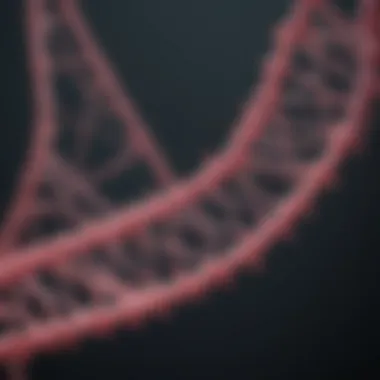Gene Predisposition to Cancer: Genetic Insights


Intro
Understanding the interplay between genetics and cancer risk is becoming increasingly important in the field of medical science. Genetic predisposition refers to the inherent genetic factors that increase an individual's likelihood of developing cancer. These genetic variations often manifest as mutations in specific genes that play critical roles in cell growth, repair, and apoptosis.
The significance of this understanding extends beyond mere risk assessment. It informs prevention strategies, guides screening processes, and shapes treatment options. As the field of personalized medicine evolves, the role of genetic testing becomes essential for identifying at-risk individuals and tailoring interventions accordingly.
Research Overview
Summary of Key Findings
Research has identified numerous genes associated with various types of cancers. For instance, the BRCA1 and BRCA2 genes are well-known markers for breast and ovarian cancers. In individuals with mutations in these genes, the risks of developing these cancers are significantly elevated.
Other mutations in genes such as TP53 and mismatch repair genes also contribute to an increased susceptibility to different cancer types. Studies reveal that while some cancers have a strong hereditary component, others may arise sporadically due to environmental and lifestyle factors.
"Understanding genetic predisposition to cancer can lead to preventive measures that are tailored to individual genetic profiles."
Background and Context
Cancer is a multifactorial disease influenced by a combination of genetic, environmental, and lifestyle factors. Research has become more focused on genetic predisposition due to advancements in genome sequencing technology. By identifying individuals at higher risk, healthcare professionals can develop targeted screening and preventive strategies.
In addition, the role of epigenetics in cancer predisposition is gaining attention. Epigenetic changes do not alter the DNA sequence but can affect gene expression and may influence cancer development. This complex relationship underscores the need for further exploration into how genetics and environmental factors converge in the etiology of cancer.
Methodology
Experimental Design
Current research often employs a wide range of experimental designs, including cohort studies, case-control studies, and family-based studies. These designs help to establish the link between specific genetic variations and cancer incidence.
Data Collection Techniques
Data collection typically involves genomic sequencing, family history assessments, and population surveys. Genetic testing has evolved to allow for comprehensive analyses of multiple genes simultaneously. Collecting data on environmental exposures and lifestyle factors helps contextualize genetic findings.
Preamble to Gene Predisposition and Cancer
The examination of genetic predisposition to cancer is a subject of immense importance in medical and scientific discourse. Understanding how genetics influences cancer susceptibility allows researchers and clinicians to identify potential risks in individuals. This area of study profoundly impacts public health strategies and personal health decisions. By shedding light on the mechanisms behind gene predisposition, we empower both the medical community and patients in the fight against cancer.
Defining Gene Predisposition
Gene predisposition refers to the increased likelihood of developing a disease based on an individual’s genetic makeup. Certain genetic variations, known as mutations, can confer a higher risk of cancer. These mutations can be inherited from one or both parents, making some individuals more vulnerable to specific types of cancer. Genetic testing has made it increasingly possible to identify these predispositions early, leading to proactive monitoring and prevention strategies. The identification of germline mutations, for example, plays a critical role in understanding risks and managing conditions before they manifest.
The Role of Genetics in Cancer
Genetics plays an undeniable role in the development of cancer. The interaction between genetic mutations and environmental factors creates a complex landscape. Some families show patterns of several relatives diagnosed with the same or related cancers, indicating a genetic link. Oncogenes and tumor suppressor genes are fundamental in this narrative. Oncogenes promote cell growth, while tumor suppressor genes normally inhibit it. When these genes do not function properly due to mutations, cancer can arise. Moreover, recent studies suggest that modifications in gene expression, without changes to the underlying DNA sequence, can also contribute to the risk of cancer.
Understanding these genetic factors is crucial for developing effective cancer prevention strategies.
As the field continues to advance, it is essential for students, reserachers, educators, and professionals to keep informed about the implications of genetic predisposition in cancer. Integrating this knowledge into clinical practice can enhance recommendations for disease prevention and targeted treatment.
The Genetic Basis of Cancer
Understanding the genetic basis of cancer is crucial. This knowledge provides insight into how specific genetic alterations can lead to the development of cancer. The genetic underpinnings not only help in identifying individuals at risk but also shape treatment strategies. A strong grasp of how genetics factors into cancer can aid in advancing prevention efforts, informing risk assessment, and enhancing personalized medicine approaches.


Understanding Oncogenes and Tumor Suppressor Genes
Cancer arises from mutations in genes that govern cell growth and division. Oncogenes are mutated forms of normal genes that, when activated, promote uncontrolled cell proliferation. Key examples include the HER2 gene in breast cancer and the K-RAS gene related to pancreatic cancer. These mutations contribute significantly to tumor development. When oncogenes are overexpressed, they can lead to aggressive tumor behavior.
In contrast, tumor suppressor genes act as safeguards against uncontrolled cell division. These genes include TP53, often referred to as the "guardian of the genome." When these genes are inactivated by mutations, cells can escape the normal growth regulatory mechanisms. Understanding the balance between oncogenes and tumor suppressor genes is critical. This balance helps in deciphering individual cancer risk and devising effective treatment plans.
Single Nucleotide Polymorphisms (SNPs)
Single nucleotide polymorphisms, or SNPs, are the most common type of genetic variation among people. These occur when a single DNA building block is altered. Not all SNPs cause disease, but some can influence an individual’s susceptibility to cancer. For instance, certain SNPs have been linked to an increased risk of developing breast cancer or prostate cancer.
Identifying these SNPs through genome-wide association studies has propelled our understanding of cancer genetics. This knowledge aids in finding potential biomarkers for early detection and risk assessment. By recognizing SNPs associated with cancer predisposition, clinicians can tailor preventative measures and screenings.
Inherited vs. Acquired Mutations
Another significant distinction in the genetic landscape of cancer is the difference between inherited and acquired mutations. Inherited mutations are passed from one generation to another. They are present in every cell and can contribute to familial cancer syndromes. An example is the BRCA1 gene mutation, which significantly increases the risk of breast and ovarian cancer.
Acquired mutations, however, arise during a person's lifetime. These mutations can result from environmental exposures, lifestyle choices, or random errors in DNA replication. They are usually found only in tumor cells. Understanding this difference is essential. It helps in determining the origin of cancer, influencing both treatment options and risk factors to manage.
"The journey of understanding cancer begins with its genetic roots. By dissecting the genetic foundation of malignancies, we open paths to innovative therapies that can change outcomes for patients."
Types of Cancer with Known Gene Predispositions
Understanding the types of cancer associated with specific gene predispositions is crucial for advancing cancer research, prevention, and treatment strategies. The identification of genetic factors that increase susceptibility to certain cancers enables targeted interventions. This knowledge allows medical professionals to recommend more precise screening methods, enabling earlier detection. Additionally, patients with known genetic risks can employ lifestyle changes or preventive measures more effectively, guiding their healthcare decisions. In this regard, genetic education plays a key role in empowering individuals.
Breast Cancer and BRCA Genes
Breast cancer is one of the most studied cancers in relation to genetic predisposition. The most well-known genes associated with breast cancer are the BRCA1 and BRCA2 genes. Mutations in these genes significantly increase the risk of developing breast and ovarian cancer. Women carrying mutations in BRCA1 have about a 72% chance of developing breast cancer by age 80, while BRCA2 mutations indicate about a 69% risk.
These mutations also raise men's risk for breast cancer, although the incidence is much lower than in women. Testing for BRCA mutations is becoming standard practice for women with a family history of breast cancer. This test allows for early surveillance, preventive mastectomy, or even chemoprevention in some cases. However, it is necessary for patients to understand the implications of positive test results and to seek genetic counseling before and after testing to navigate the complex emotional and medical decisions that follow.
Colorectal Cancer and Lynch Syndrome
Colorectal cancer is another domain where genetic predisposition is evident, particularly through Lynch syndrome. This hereditary condition is linked to mutations in mismatch repair genes such as ML, MS, MSH6, and PMS2. Individuals with Lynch syndrome have a higher risk of developing colorectal cancer, often at a younger age, along with other cancers, including endometrial cancer.
Early screening is vital for those with Lynch syndrome because it significantly affects outcomes. Typically, regular colonoscopies begin at a much earlier age compared to the general population, usually before age 30. Identifying Lynch syndrome not only helps the individual but also has implications for family members. Since this syndrome is hereditary, family members may also benefit from screening and preventive measures.
"Genetic predisposition to cancer is a pivotal piece in the larger puzzle of cancer prevention. Understanding these links can save lives."
Ovarian Cancer and Other Relatives
Ovarian cancer, much like breast cancer, is closely tied to inherited genetic mutations, particularly the BRCA genes mentioned previously. Women with BRCA1 mutations have an estimated 44% risk of ovarian cancer, while those with BRCA2 mutations face approximately a 17% risk. Family history plays a significant role here, as having close relatives with ovarian cancer raises individual risk.
Moreover, there are other less common genetic syndromes linked to ovarian cancer, such as the Fanconi anemia pathway and hereditary nonpolyposis colorectal cancer (HNPCC). These syndromes not only heighten the risk of ovarian cancer but also increase susceptibility to other cancers. Genetic history can inform surgical decisions, such as prophylactic oophorectomy, to reduce the risk of developing ovarian cancer.
The Mechanisms of Genetic Predisposition
The understanding of genetic predisposition to cancer necessitates examining various underlying mechanisms. The topic is crucial as it provides insight into how genetic factors contribute to the initiation and progression of cancer. By learning about these mechanisms, researchers and medical professionals can devise targeted prevention strategies and personalized treatment plans. Insights gained from studying genetic predisposition are not only essential for individuals at risk but also hold significant implications for the broader cancer research community.
How Genetic Mutations Initiate Cancer Processes
Genetic mutations play a vital role in the development of cancer. These alterations can disrupt normal cellular functions. They can be classified into several categories such as point mutations, insertions, deletions, and chromosomal rearrangements. Oncogenes and tumor suppressor genes are crucial in this context.
- Oncogenes are mutated forms of normal genes that promote cell division and survival. When these genes become overactive, they can lead to uncontrolled growth of cells.
- Tumor suppressor genes normally function to inhibit cell proliferation or induce apoptosis. Mutations that inactivate these genes can prevent the body from regulating cell growth effectively.


The cumulative effect of mutations can create an environment conducive to tumor formation. This implies that understanding mutations could pave the way for innovative therapeutic approaches.
Epigenetics and Cancer Risk
Epigenetics refers to heritable changes in gene expression that do not involve alterations to the underlying DNA sequence. Epigenetic modifications can influence cancer risk through mechanisms such as DNA methylation and histone modification. Certain environmental or lifestyle factors can lead to epigenetic changes, which may contribute to cancer development.
For instance, the methylation of specific genes can silence their expression, preventing tumor suppressor genes from doing their job. Studies indicate that epigenetic modifications play a role in various cancers, making them an important area of research. Addressing epigenetic changes might present new avenues for cancer therapy.
Gene-Environment Interactions
Gene-environment interactions represent the dynamic interplay between genetic predispositions and external influences such as diet, pollution, and radiation. These interactions can modify cancer risk significantly. For example, individuals who carry certain genetic variants may be more susceptible to the harmful effects of environmental toxins
- A classic example is the increased risk of lung cancer in smokers with specific genetic mutations in their DNA repair genes.
- Conversely, individuals with protective genetic variants might show resilience against certain environmental risks.
This intricate relationship underlines the complexity of cancer risk assessment, emphasizing the need for integrative models that consider both genetic and environmental factors. Understanding these variations helps in tailoring public health interventions and screening programs.
"Cancer is not just a matter of genetics. It is the intricate dance of genetic risks with environmental factors that shapes the individual risk profile."
Addressing the mechanisms of genetic predisposition provides a clearer perspective on cancer development. This understanding aids in the quest for effective prevention and treatment strategies essential for improving patient outcomes.
Implications of Genetic Testing
Genetic testing holds a significant place in understanding the connections between gene predisposition and cancer development. With advancements in technology, the process of genetic screening has become more refined and accessible. This section explores vital aspects of genetic testing, emphasizing its benefits, the interpretation of results, and ethical considerations surrounding this burgeoning field.
The Process of Genetic Screening
The journey of genetic screening involves multiple stages. Initially, individuals may consider genetic testing if they have a family history of certain cancers or if they display other preliminary risk factors. A health professional typically initiates testing by providing a detailed clinical consultation. This is crucial for determining which specific genes should undergo testing.
Once the need is established, the next step often involves the collection of samples, usually through blood or saliva. These samples serve as the basis for analysis in a laboratory. Next, advanced techniques such as next-generation sequencing can identify genetic mutations or variations linked to cancer predisposition.
One potential outcome is the identification of known pathogenic mutations. Alternatively, test results may show variants of uncertain significance, which require further study and evaluation. Thus, practitioners must guide patients through these complexities, ensuring clarity and understanding about what the findings imply for both their health and familial implications.
Understanding Genetic Test Results
Interpreting genetic test results is a critical element. The result may reveal whether the patient carries specific mutations associated with an increased risk for certain types of cancer. For example, results may indicate the presence of mutations in the BRCA1 or BRCA2 genes, which could place an individual at higher risk of breast or ovarian cancer.
Understanding these results involves considering not just the presence of mutations but also the overall risk and the individual's context. It is important for patients to have a supportive environment to discuss these findings with genetic counselors or healthcare providers. They can provide essential insights into how genetic predispositions may influence cancer surveillance strategies, preventive measures, or treatment options.
Ethical Considerations in Genetic Testing
Ethical issues arise from genetic testing that impact both individuals and their families. Issues surrounding privacy and confidentiality are paramount, as genetic information can reveal sensitive details about an individual that may affect family dynamics.
Additionally, the prospect of knowing one’s genetic predisposition to cancer evokes questions regarding psychological wellbeing. Some individuals may experience anxiety or distress after learning of their risk. This underscores the importance of counseling before and after the genetic testing process. Genetic counselors can aid in conveying risks clearly and help manage emotional responses to test outcomes.
Moreover, implications extend beyond the individual; familial implications necessitate discussions about how shared genetic information should be communicated. It is necessary to weigh the benefits of knowing against potential emotional burdens on relatives. Whether through potential discrimination in employment or insurance based on genetic information, the ethical landscape remains complex and warrants careful consideration.
In summary, the implications of genetic testing are vast. They involve technical processes, interpretations of risk, and critical ethical questions. A nuanced understanding can aid in better decision-making for patients, providing them with essential knowledge to navigate their health with informed choices.
Challenges in Research and Treatment
Understanding the challenges in cancer research and treatment is essential for progressing in the field of genetic predisposition. The interplay between genetics and the environment influences cancer development in many ways. As researchers dive into these complexities, they uncover new knowledge that could change how we perceive and approach cancer treatment. However, several obstacles hinder the swift advancement of effective strategies.


Limitations of Current Genetic Research
Current genetic research has its limitations that impact treatment outcomes and the accuracy of findings. Despite advancements, technology can only capture a portion of the genetic puzzle. Some limitations include:
- Sample Size: Many studies use small sample sizes, which can skew results and limit the applicability of findings to the broader population.
- Focus on Single Genes: Research often zeroes in on specific genes, such as BRCA1 and BRCA2, neglecting the complex interactions that involve multiple genes and their combined effects.
- Underrepresentation of Diverse Populations: Much of the genetic research is dominated by data from specific ethnic groups. This lack of diversity hampers the understanding of how genetic variants affect different populations.
- Environmental Factors: The interaction of genetic predispositions with lifestyle and environmental factors can complicate the research. Understanding these variables is crucial for developing comprehensive risk models.
These limitations can lead to incomplete conclusions and reduce the effectiveness of treatments aimed at specific genetic markers.
The Complexity of Gene Interactions
The interactions between genes create a multilayered landscape that adds complexity to cancer research. Various genes do not function in isolation; instead, they interact with one another and with external factors, such as environmental exposures and diet. The implications of this complexity are profound, as outlined below:
- Gene Networks: Genes operate in networks; mutations in one gene can affect many others. This interconnectedness makes it challenging to pinpoint the precise cause of cancer.
- Epistatic Interactions: The concept of epistasis refers to how one gene can mask or alter the expression of another gene. Disentangling these interactions requires sophisticated methodologies.
- Modifier Genes: Some genes can modify the risk associated with known cancer predisposition genes. These modifier genes can either increase or decrease the likelihood of developing cancer, adding another layer of complexity.
- Environmental Influences: Gene-environment interactions further complicate our understanding. Factors such as exposure to pollutants or certain diets can influence gene expression and cancer risk.
The challenges posed by complex gene interactions highlight the need for more integrated research approaches. These approaches should consider various genetic and environmental influences to advance our understanding of cancer predisposition.
Cancer is not solely a genetic disease; it is a nexus of multiple factors needing careful study to find effective solutions.
Future Directions in Cancer Research
The landscape of cancer research is rapidly evolving, driven by advancements in technological capabilities and a deeper understanding of genetic underpinnings. Each breakthrough not only sheds light on fundamental processes involved in cancer but also opens pathways for novel treatment strategies. Exploring future directions in cancer research is imperative to enhance prevention methods and improve patient outcomes.
Advancements in Genetic Technologies
Recent progress in genetic technologies offers promising prospects for cancer research. Techniques such as next-generation sequencing (NGS) and CRISPR-Cas9 gene editing are becoming more sophisticated and accessible. These tools enable researchers to analyze genetic mutations with greater precision and speed.
NGS allows for whole-genome sequencing, providing a comprehensive view of genetic alterations in tumors. By identifying specific mutations, it is possible to develop targeted therapies that address the unique characteristics of an individual's cancer. Moreover, this technology aids in understanding the heterogeneity of tumors, which is essential for effective treatment.
CRISPR-Cas9 technology, on the other hand, holds the potential of correcting genetic mutations responsible for cancer. Researchers can precisely modify genes, either to deactivate oncogenes or to enhance the function of tumor suppressor genes. Innovation in these areas will likely lead to the development of personalized gene therapies, advancing the field of oncology.
Personalized Medicine Approaches
The shift towards personalized medicine represents a transformative approach to cancer treatment. This strategy tailors therapies based on the genetic profile of both the patient and the tumor. Unlike traditional methods that take a one-size-fits-all approach, personalized medicine acknowledges that each cancer presents a unique set of challenges.
By integrating genetic testing into routine clinical practice, it becomes feasible to identify patients who are most likely to respond to specific treatments. For example, mutations in the KRAS gene may indicate resistance to certain therapies for colorectal cancer. Understanding such genetic indicators allows healthcare providers to customize treatment plans, improving the chances of successful outcomes.
Additionally, ongoing research is aimed at discovering novel biomarkers that could predict treatment response or monitor disease progression. These markers will likely pave the way for more effective preventive measures, enabling earlier intervention in hereditary cancer cases.
As personalized medicine evolves, it has the potential to dramatically change the way cancers are treated, ultimately leading to better survival rates and quality of life for patients.
The End
The exploration of gene predisposition to cancer has significant implications for how we understand and approach this complex disease. The article has delineated the nuanced relationships between genetic variations and cancer risk, emphasizing that genetic factors do not act in isolation. Advances in genetic research can lead to more substantial insights into how specific genes influence cancer development. Integrating this knowledge into clinical practice is essential for improving cancer prevention and treatment strategies.
Summarizing Key Findings
Throughout the article, key findings have emerged regarding the genetic basis of cancer. We covered the following points:
- Genetic Mutations: Oncogenes and tumor suppressor genes play pivotal roles in tumor development. Mutations in these genes can lead to uncontrolled cell division.
- Inherited Risks: Certain cancers, such as breast cancer linked to BRCA genes, demonstrate how hereditary factors significantly raise risk.
- Environmental Interactions: Gene-environment factors affect cancer risk, showcasing the complex interplay of genetics and lifestyle.
These findings underline the importance of understanding genetic predisposition as a tool for effective cancer management.
The Importance of Continued Research
Research in this field is crucial for several reasons:
- New Discoveries: Genetic research is continually uncovering novel associations between genes and cancer types. This may lead to innovative interventions or treatments.
- Early Detection: Continued investigation assists in developing genetic screening tools. These tools can help identify individuals at high risk for certain cancers, facilitating proactive measures.
- Therapeutics Development: As more is known about the genetic makeup of cancers, personalized treatments can be created that target specific genetic profiles. This can significantly improve patient outcomes.
In summary, the ongoing research into genetic predisposition not only enhances our comprehension of cancer biology but also has the potential to change the landscape of oncology, moving us towards more personalized and effective healthcare.







